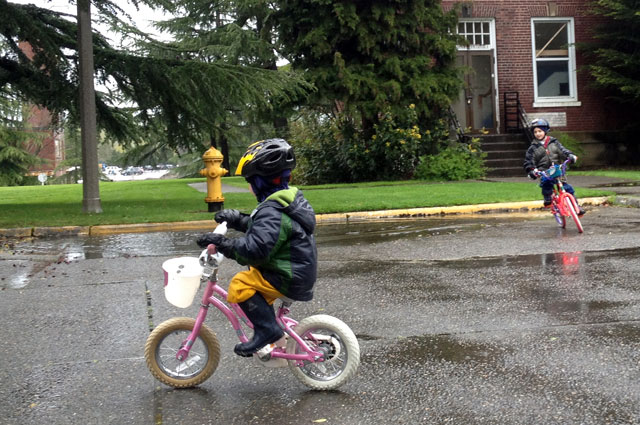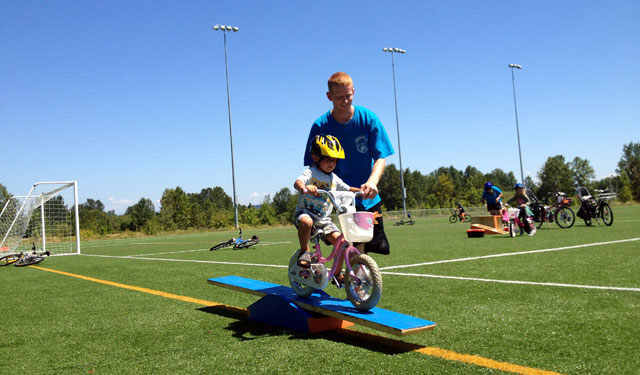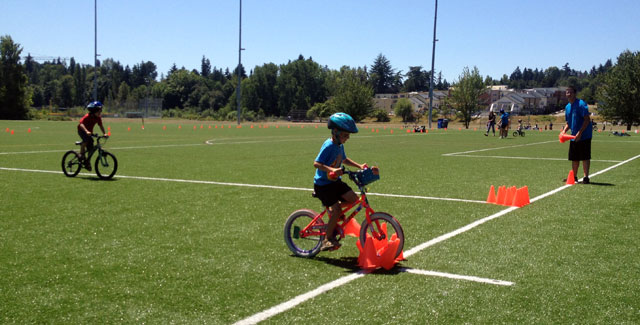
(Photos: Madi Carlson)
Hey kids, how’s it going with those new Christmas bikes? For some of us, it takes a while to get pedaling — my younger brother started riding without training wheels long before I was able to. But fear not, I have some tips for you!
➤ Remove your pedals
Turn that bike temporarily into a balance bike! Even if — actually, especially if — you’re graduating from a balance bike, your new pedal bike is going to be bigger and heavier and you’ll appreciate getting used to its heft before you need to add a new skill.
“Hey Madi, this sounds awfully familiar, haven’t you mentioned removing pedals before?”

Good memory, kid! I did indeed when I spoke about balance bikes and other preludes to pedaling their own set of wheels. I also suggested that if you didn’t want to bring your bike to your local bike shop to have the pedals removed, you can DIY with a $10 consumer quality pedal wrench: your right pedal is rightly righty-tighty-lefty-loosy, but your left pedal is the opposite. So remove those pedals, lower the saddle all the way, and scoot around to your heart’s content.

➤ Coast downhill
Once you’ve had some time to get used to pushing your bike around, put those pedals back on but don’t take to the streets or sidewalks just yet. Find a small grassy hill and coast down it with your feet on the pedals. You’ll probably want to do this a bunch of times and coast to a stop, but this is also a good time to get used to your brake(s), too. American kid bikes are required to have a coaster (foot) brake if they have wheels smaller than 20 inches so there’s a good chance that’s all you’ve got. If you’re lucky, you’ve scored a European or Canadian bike that you can backpedal, but if not, you’ll need to be careful about inadvertently pressing backwards on a pedal and coming to an unexpected stop. Your bike might also have one or two handbrakes — left hand is front wheel, right hand is back wheel, and bikes with only one handbrake can come either way, front or back.
Advertisement
➤ Coast and pedal
Same hill, same start, but pedal once you’re near or at the bottom to keep your momentum going a bit longer. You’re biking now!

➤ Get off the grass
Grass is fun to coast down and it’s less scary than asphalt or pavement, but it’s kind of hard to pedal on, right? You’re ready to move to flat firm ground now. Getting started is the hard part so you might want a push from an adult to get your momentum going the first few times, but with or without an assist, make sure your foot of choice is in the “power position,” about 45 degrees from the top, ready to push forward.
➤ Add training wheels
Wait, what? Yes, really, add training wheels temporarily unless you truly got the hang of using your brake(s) in the previous steps. Lots of kids like the pedaling part, but aren’t so interested in the braking part so we parents can calm our nerves if you’ll just spend a couple hours in training wheels to control your speed while you focus on getting used to those brakes. But don’t do this step until you’re really adept at pedaling, you can learn the pedaling part without the training wheels, really!

➤ Isn’t there some magical product that can help me?
Ooh, there used to be! The Gyrobike Gyrowheel gyroscopic bicycle wheel kept 12- and 16-inch bikes upright and kids quickly gained confidence to pedal without the gyro. Gyrobike’s intellectual property was acquired by a new company called Jyrobike who hoped to Kickstart a new product, but disappeared before shipping so the one Gyrowheel on eBay right now (search for gyrobike) might be the only one left.
➤ Do these steps work for adults, too?
These steps totally work for adults, too, even down to finding training wheels sized for adult bikes!
Do you have a pedaling success story to share in the comments? Or a plea for help? I’m full of advice beyond just the general steps above and I’ll be happy to answer questions in the comments. Thanks for reading!
Remember, we’re always looking for people to profile. Get in touch if it sounds like fun to you. I’d especially like to feature families of color so please get in touch or ask friends of color who bike with their kids if they’re interested in sharing their stories. And as always, feel free ask questions in the comments below or email me your story ideas and insights at madidotcom [at] gmail [dot] com.
— Madi Carlson, @familyride on Instagram and Twitter
Browse past Family Biking posts here.
Never miss a story. Sign-up for the daily BP Headlines email.
BikePortland needs your support.


